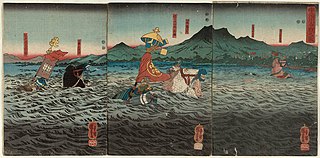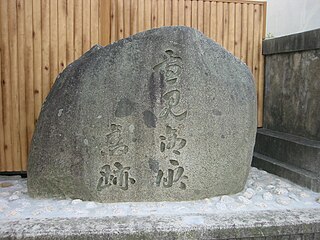
Year 1180 (MCLXXX) was a leap year starting on Tuesday of the Julian calendar.

Taira no Kiyomori was a military leader and kugyō of the late Heian period of Japan. He established the first samurai-dominated administrative government in the history of Japan.

Minamoto no Yoshitsune was a military commander of the Minamoto clan of Japan in the late Heian and early Kamakura periods. During the Genpei War, he led a series of battles that toppled the Ise-Heishi branch of the Taira clan, helping his half-brother Yoritomo consolidate power. He is considered one of the greatest and the most popular warriors of his era, and one of the most famous samurai in the history of Japan. Yoshitsune perished after being betrayed by the son of a trusted ally.

The Genpei War was a national civil war between the Taira and Minamoto clans during the late Heian period of Japan. It resulted in the downfall of the Taira and the establishment of the Kamakura shogunate under Minamoto no Yoritomo, who appointed himself as Shōgun in 1192, governing Japan as a military dictator from the eastern city of Kamakura.

The Tale of the Heike is an epic account compiled prior to 1330 of the struggle between the Taira clan and Minamoto clan for control of Japan at the end of the 12th century in the Genpei War (1180–1185). Heike (平家) refers to the Taira (平), hei being the on'yomi reading of the first kanji and "ke" (家) means family. Note that in the title of the Genpei War, "hei" is in this combination read as "pei" and the "gen" (源) is the first kanji used in the Minamoto clan's name.

Prince Mochihito, also known as the Takakura Prince, and as Minamoto no Mochimitsu, was a son of Emperor Go-Shirakawa of Japan. He is noted for his role in starting the Genpei War.

Minamoto no Yorimasa was a Japanese poet, aristocrat and samurai lord. His poetry appeared in various anthologies. He served eight different emperors in his long career, holding posts such as hyōgo no kami. As a general, he led the Minamoto armies at the beginning of the Genpei War.

Following the 1180 Battle of Uji, in which Minamoto no Yorimasa fought a small Taira army with the help of monks from the Mii-dera and other temples, the victorious Taira sought revenge. They burned the Miidera temple, before moving on to Nara, where they "set fire to the monastic complexes of Kōfuku-ji and Tōdai-ji."

Sōhei were Buddhist warrior monks of both classical and feudal Japan. At certain points in history, they held considerable power, obliging the imperial and military governments to collaborate.

Nagara-san Onjo-ji, also known as just Onjo-ji, or Mii-dera (三井寺), is a Buddhist temple in Japan located at the foot of Mount Hiei, in the city of Ōtsu in Shiga Prefecture. It is a short distance from both Kyoto, and Lake Biwa, Japan's largest lake. The head temple of the Jimon sect of Tendai, it is a sister temple to Enryaku-ji, at the top of the mountain, and is one of the four largest temples in Japan. Altogether, there are 40 named buildings in the Mii-dera complex.
Gochi-in no Tajima, called Tajima the arrow-cutter, was a sōhei from Mii-dera who fought alongside the Minamoto clan forces, and many of his fellow Mii-dera monks at the Battle of Uji in 1180.
Tsutsui no Jōmyō Meishū (筒井浄妙明秀) was a warrior monk (sōhei) from Mii-dera who fought alongside Minamoto no Yorimasa and his fellow monks at the Battle of Uji in 1180, defending the Byōdō-in and Prince Mochihito from the Taira clan.
Ichirai was a Japanese warrior monk who supported the Minamoto clan of samurai against their rivals, the Taira clan.

Sasaki Takatsuna was a Japanese samurai commander in the Genpei War, the great conflict between the Minamoto and Taira clans.
Minamoto no Kanetsuna was a son of Minamoto no Yorimasa.

Minamoto no Nakatsuna was a Japanese samurai lord. He was the elder son of Minamoto no Yorimasa, and fought in the Battle of Uji in 1180, during the Genpei War. Together with his father and younger brother Minamoto no Kanetsuna, the three fought against the Taira clan. However, they were unable to defeat the enemy so they safely returned to Byōdō-in temple for a short time. While Yorimasa's sons defended the temple, Yorimasa committed seppuku rather than surrender. Nakatsuna soon followed.

Fukuhara-kyō was the seat of Japan's Imperial Court, and therefore the capital of the country, for roughly six months in 1180. It was also the center of Taira no Kiyomori's power and the site of his retirement palace.

Hasebe Nobutsura (year of birth unknown - Kempo-6 was a military commander between the end of Heian period and the beginning of Kamakura period. He was the son of Tametsura who was an officer for managing horses, Uma-no-jo
Minamoto no Yoshikiyo was a Japanese samurai military commander, feudal lord, and courtier in the late Heian period of Japan's history. He took part in the Genpei War as a general for Minamoto no Yoshinaka, leading Yoshinaka's army against the Taira clan at the Battle of Mizushima where he was defeated and perished. His descendants would go on to form the Hosokawa clan and gain influence and power during the Ashikaga Shogunate and the subsequent Sengoku and Edo Periods as Daimyo.















